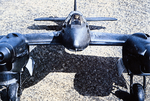davparlr
Senior Master Sergeant
This is a myth! After Mr. Hermann there is no single document available to prove this myth/theorie.
After his reasearch the RLM come to the conclusion that the FW 187 nightfighter was coming to late or at the same timeline with the He 219 in production and the RLM don't want to produce two new nightfighters, so the RLM decided pro He 219!
That are the reasons from the documents.
Actually I am not sure it is a myth. The fuselage is very small on the Fw-187, not much bigger than a man sitting with his legs straight out. I will try to do some measuring. I think I will find that the Bf-110 fuselage is much larger than the Fw. From the attached picture my question is, Where do you stick the radar, second crewman, two 20mm cannon and four machine guns and their ammo? Major modifications required! At the very least it would be marginal in growth. Just compare this to the He-219.

